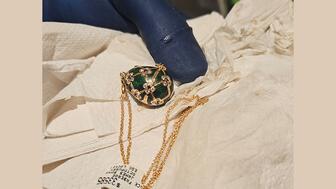The special-edition egg pendant ingested in a New Zealand jewelry store was recovered after a six-day wait.
Column: The price of integrity
Whether retailers choose to discount or not, it is vitally important that they have integrity in their pricing, columnist Peter Smith writes.
In visiting some retail stores in recent weeks, I have noticed a disturbing pattern on pricing.

The premise of marking up to discount has, of course, been around for many years. I was first introduced to it in the early to middle 1980s, when I spent a few years working for the now defunct Whitehall Jewellers (they used the English spelling.)
Having worked in the jewelry business for many years before my Whitehall stint, I was not a novice to discounting per se. However, my previous experience in the old country (Ireland) had always been, well, legitimate. If we offered discounts at McGowan’s Jewellers (Irish spelling) it was for a limited time--post-Christmas sale or on products that we were trying to liquidate. We had never used pricing to convince the customer that they were getting a deal unless they were, quite honestly, getting a deal.
In my most recent visit to a retail partner, I discovered that they had marked up products from my company far beyond the recommended retail price points, which provided healthy retail margins as it was. The prices were high enough that any reasonably well-informed customer would likely question the viability of the pricing not just on those items, but across the entire store. In fact, at a recent trunk show, one of our team had personally witnessed three separate examples of customers reacting viscerally, and very negatively, to the grossly inflated pricing that the retailer had put on the products.
Despite his embarrassment, knowing as he did what we had sold the products for and what the recommended retail pricing should have been, there was nothing our guy could do to convince the customer to refrain from completely disengaging while he “checked in with the owner” as to what might be done about the price.
The damage had been done and those customers at that particular trunk show had a very sobering introduction to the notion of pricing integrity. They knew that something didn’t smell right and the retailer’s intent to use the artificially and unreasonably high ticket prices as
As I mentioned, we also saw other cases of retailers who had previously enjoyed very good sell-through with our product only to have the sales hit a brick wall for “no apparent reason.” In each case, of course, we discovered that they had made the decision to extend the mark-up far beyond what was recommended and what was reasonable. As soon as the conversations were had, and the retail tickets changed to reflect the more appropriate retail pricing, the sell-through recovered and the damage was reversed. Or was it?
One can debate the merits of discounting versus not discounting but there are, of course, no absolute right or absolute wrong answers. Each retailer must embrace openly and honestly the practice that they believe is right for their business. If you believe that discounting is the way to compete, and you can run a healthy business on the margins you make, then who is to say that strategy is wrong? If you choose to price your products appropriately and sell on value, knowing that you won’t win the customer who is hell-bent on getting a “deal,” than you owe no apology to anyone for that strategy.
No matter which of the aforementioned approaches you deem best for you, what is vitally important is that you have integrity of pricing.
The earlier mentioned and now-closed Whitehall Jewellers had a pricing model that was based on illusion. The company was able to effect a sizable expansion by convincing customers that they were getting a great deal. The ubiquitous 50/60/70 percent off (retail) banners hung from the rafters and enough people seemed to buy into the illusion of value for about a decade.
Having spent a few years working behind the counters in different Whitehall stores, my own inclination was that customers didn’t really believe that they were getting 60 percent off the original price at all. They knew that those discounts were a sham, but for some period of time enough of them were still willing to believe that even if the “original price” was bogus, they were still getting a deal. The model, ultimately, failed.
I personally am not a fan of discounting because it presumes one of three things:
1. The customer is getting a real deal, in which case I wonder where the margins will come from to run the business. Good for the consumer, bad for the store.
2. That you can compete long term on a “lowest price” model. There’s generally only one winner in that game.
3. Or, as mentioned, the pricing model is actually misleading and illusionary. There likely would be enough customers who are smart enough to see through that, and ultimately it will reflect very poorly on the store in the short and long term.
Martin Lindstrom, the author of Buy-ology: Truths and Lies About Why We Buy, cites multiple studies about the long-term costs of discounting. Lindstrom writes that the studies show that it takes seven years for a brand to recover its value in the minds of consumers when it has been discounted.
Michael Raynor and Mumtaz Ahmed wrote in their book, The Three Rules: How Exceptional Companies Think, that extensive research shows that companies that devoted their energies and resources to the “non-price value” ultimately ended up far better off than companies that chased a “price” value strategy.
Again, retail stores will choose the best course for them, be it price value or non-price value, but whichever direction one chooses, it ought to have at its core the basic premise of price integrity.
The illusionary approach may appear to be working in the short-term, but it is not a sound strategy for long-term growth or for customer loyalty.
Peter Smith, author of Hiring Squirrels: 12 Essential Interview Questions to Uncover Great Retail Sales Talent, has spent more than 30 years building sales teams at retail and at wholesale. He is president of Vibhor Gems and he has previously worked with companies such as Tiffany & Co., Montblanc and Hearts On Fire. Email him at peter@vibhorgems.com, dublinsmith@yahoo.com or reach him on LinkedIn.
The Latest
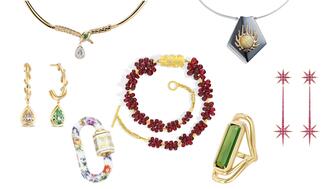
Associate Editor Natalie Francisco plays favorites with Piece of the Week, selecting a standout piece of jewelry from each month of 2025.

The “Love and Desire” campaign is inspired by the magic that follows when one’s heart leads the way, said the brand.

How Jewelers of America’s 20 Under 40 are leading to ensure a brighter future for the jewelry industry.

Two awardees will receive free tuition for an educational course at the Swiss lab, with flights and lodging included.


Berta de Pablos-Barbier will replace Alexander Lacik at the start of January, two months earlier than expected.

Sotheby’s held its first two jewelry sales at the Breuer building last week, and they totaled nearly $44 million.

Roseco’s 704-page catalog showcases new lab-grown diamonds, findings, tools & more—available in print or interactive digital editions.

Winners will receive free registration and lodging for its fourth annual event in Detroit.

Here are six ideas for making more engaging content for Instagram Reels and TikTok, courtesy of Duvall O’Steen and Jen Cullen Williams.

The honorees include a notable jewelry brand, an industry veteran, and an independent retailer.

Carlos Jose Hernandez and Joshua Zuazo were sentenced to life without the possibility of parole in the 2024 murder of Hussein “Sam” Murray.

Yood will serve alongside Eduard Stefanescu, the sustainability manager for C.Hafner, a precious metals refiner in Germany.

The New Orleans jeweler is also hosting pop-up jewelry boutiques in New York City and Dallas.

Set in a Tiffany & Co. necklace, it sold for $4.2 million, the highest price and price per carat paid for a Paraíba tourmaline at auction.

The jeweler’s “Deep Freeze” display showcases its iconic jewelry designs frozen in a vintage icebox.
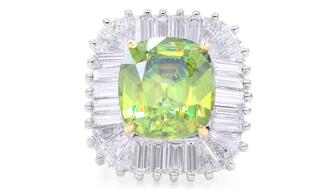
Take luxury gifting to new heights this holiday season with the jeweler’s showstopping 12-carat sphene ring.

This year's theme is “Unveiling the Depths of the Ocean.”

In its annual report, Pinterest noted an increase in searches for brooches, heirloom jewelry, and ‘80s luxury.

Starting Jan. 1, customers can request the service for opal, peridot, and demantoid garnet.

The 111-year-old retailer celebrated the opening of its new location in Salem, New Hampshire, which is its third store in the state.

The new catalog features its most popular chains as well as new styles.

The filmmaker’s personal F.P. Journe “FFC” prototype was the star of Phillips’ recent record-setting watch auction in New York.

The new location in the Design District pays homage to Miami’s Art Deco heritage and its connection to the ocean.

Inflations, tariffs, and politics—including the government shutdown—were among consumers’ top concerns last month.
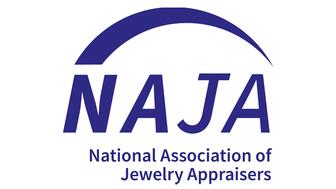
“Longtime favorite” presenters, as well as first-time speakers, will lead talks and workshops at the annual event in Tucson next year.
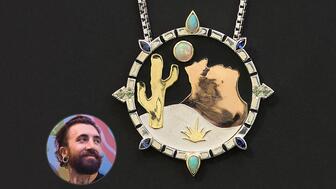
Silas Smith of Meridian Metalworks won the challenge with his pendant that blends Australian and American landscapes.














